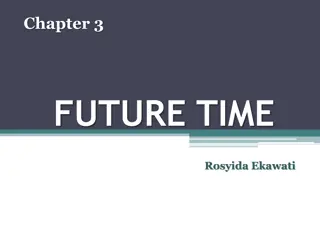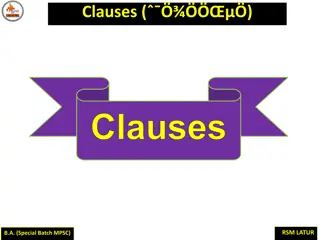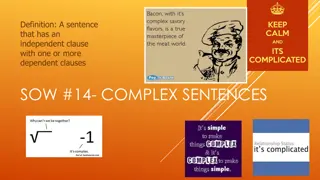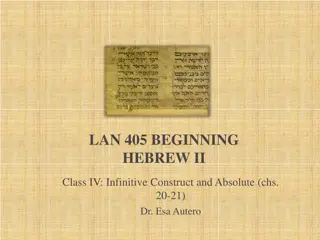Understanding Dependent Clauses and Verb Forms in Biblical Hebrew
Learn to identify dependent clauses using relative pronouns and read the background of Qal qatal in a Bible study lesson based on Exodus 18:1. Explore the forms of the verbs, subject, and object, along with the pronunciation and translation of specific Hebrew words. Understand the significance of qatal verb form and its relationship with wayyiqtol in Hebrew grammar.
Download Presentation

Please find below an Image/Link to download the presentation.
The content on the website is provided AS IS for your information and personal use only. It may not be sold, licensed, or shared on other websites without obtaining consent from the author. Download presentation by click this link. If you encounter any issues during the download, it is possible that the publisher has removed the file from their server.
E N D
Presentation Transcript
Rocine Lesson 4 Exodus 18:1
Goals Identify a dependent clause by a relative pronoun. Identify and read the relative past background Qal qatal in a dependent clause.
What we already know What form is the first verb? What genre does that form indicate? What is the Subject? Object?
What we already know What form is the first verb? What genre does that form indicate? What is the Subject? Object? wayyiqtol Historical Narrative
What we already know How is pronounced? Meaning of (Vocab # 27, p 412) Translate what we can.
What we already know kol How is pronounced? Meaning of (Vocab # 27, p 412) Translate what we can. short o qamets-hatuph, not the long a qamets. Remember closed, unaccented syllable means qamets-hatuph.
All-purpose Relative Pronoun (Vocab # 2, p 411) The all-purpose relative pronoun in BH Trans: what, that, who, which, whomever Signals a dependent clause
All-purpose Relative Pronoun (Vocab # 2, p 411) The all-purpose relative pronoun in BH Trans: what, that, who, which, whomever Signals a dependent clause Two other words that start a dependent clause = "if" (Vocab # 39, p 412) = "when, because" (Vocab # 8, p 412)
Find the dependent clause. Why can t dependent clauses stand alone?
Qatal Qatal is a verb form (like wayyiqtol). Try to identify the qatal and the wayyiqtol.
Qatal qatal wayyiqtol List as many similarities/differences as you can.
Qatal qatal wayyiqtol List as many similarities/differences as you can. Differences prefix vs. no prefix waw/patach/dagesh forte front end vowels are different Similarities 3 root letters subject follows
Mainline vs. Off-the-line qatal wayyiqtol RULE: Every genre of discourse has a mainline clause type constructed with a particular verb form. All other clause types (constructed with other verb forms) within that genre are off-the-line. Off-the-line clauses are subordinate to, or serve the mainline. Each off-the-line verb form has functions that are particular to it.
Mainline vs. Off-the-line qatal wayyiqtol In this verse which verb form is Mainline? Off-line?
Mainline vs. Off-the-line qatal wayyiqtol In the Historical Narrative genre Wayyiqtol is mainline This is the tense used to move the story forward, to describe each event in sequence. Qatal is off-line Qatal will do things in the story other than tell us what the next event is.
Qatal qatal wayyiqtol Qatal can be used in 2 ways in Historical Narrative Both are off-line In a dependent clause In an independent clause (next lesson) (this lesson)
Qatal in dependent clause qatal wayyiqtol In a dependent clause, Qatal gives relative past background information This is information set in the past, relative to the time frame of the story
Qatal in dependent clause qatal wayyiqtol In a dependent clause, Qatal gives relative past background information This is information set in the past, relative to the time frame of the story The Qatal is in a dependent clause when it follows or or
Qatal in dependent clause qatal wayyiqtol past present future
Qatal in dependent clause qatal wayyiqtol What God did Jethro heard past present future qatal wayyiqtol
Qatal in dependent clause past present future
Qatal in dependent clause qatal wayyiqtol past present future
Qatal in dependent clause qatal wayyiqtol past present future
Qatal in dependent clause qatal wayyiqtol YHWH made man YHWH regretted past present future qatal wayyiqtol
Qatal in dependent clause qatal wayyiqtol qatal wayyiqtol past present future qatal wayyiqtol
Qatal in dependent clause qatal wayyiqtol qatal wayyiqtol Past relative to past past present future qatal wayyiqtol
Qatal in dependent clause qatal wayyiqtol RULE: A qatal form, when in a dependent clause, functions in Biblical Hebrew by giving background in the relative past. Relative past means past as compared to the main clause of the sentence. In Historical Narrative the main clause will most often be the wayyiqtol clause.
Qatal What does it look like? qatal wayyiqtol Wayyiqtol has prefixes. (stuff that comes before the root) Qatal has affixes. (stuff that comes after the root) Note that in this particular qatal, the affix is Null , in other words there isn t one. This is the base form. It s the form used for he , 3rd masculine, singular.
Qatal What does it look like? qatal wayyiqtol Here are a couple more qatals just to see some of the variety. This is not a full list. , ] [ [ ] affix meaning he affix meaning you
Qatal What does it look like? Let s try parsing these verbs. Person, Gender, Number Root Stem Form Function Root meaning Note 1: A Qatal form in the Qal stem will have qamets under the first root letter. Note 2: The word order with the Qatal here is the same as usual: V-S (verb then subject).
Qatal What does it look like? Let s try parsing these verbs. Person, Gender, Number Root Stem Form Function Root meaning Historical Narrative Mainline Qal Wayyiqtol 3ms To hear Note 1: A Qatal form in the Qal stem will have qamets under the first root letter. Note 2: The word order with the Qatal here is the same as usual: V-S (verb then subject).
Qatal What does it look like? Let s try parsing these verbs. Person, Gender, Number Root Stem Form Function Root meaning Historical Narrative Mainline Qal Wayyiqtol 3ms To hear Qatal in dep. clause = Rel. past background Qal Qatal 3ms To do Note 1: A Qatal form in the Qal stem will have qamets under the first root letter. Note 2: The word order with the Qatal here is the same as usual: V-S (verb then subject).























